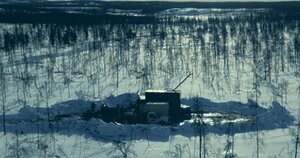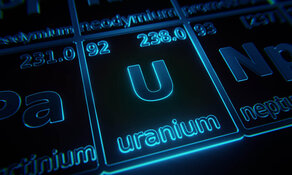David Sadowski: Over the next decade, we expect uranium demand to grow at about 3% per year (3%/year) with about two-thirds of that incremental buying coming from China, Russia and India. China is building reactors like they're going out of style—30 units are currently under construction domestically, with 59 in the planning stage — and we've just seen China grow its presence internationally with an equity stake in the Hinkley Point power station in the U.K. Russia is building 10 reactors at the moment. It's got 28 on the drawing board, according to the World Nuclear Association, and that's going to more than offset the retirement of some of its aging reactors. Russia is heavily involved in vending reactors globally as well, with projects around the world. One interesting aspect of that is the build-own-operate model, where Russia will build and operate a plant in your country and then sell you electricity from that plant. In India, despite some headwinds with the nuclear liability law, another new reactor just connected to the grid, an additional six units are currently under construction and five dozen are on the drawing board. You've got new entrants like the United Arab Emirates, Turkey and Vietnam showing that they're very serious about nuclear as a power source.

source: Raymond James Ltd., UxC, WNA, NIW, Company Reports.
On the other hand, although the U.S., the world's largest nuclear power producer, is building three large reactors and two more are due to start construction imminently, utilities have decided to close five small, old reactors due to challenging economics, with a handful more at risk of closure. In France you've got some talk about reducing its very heavy reliance on nuclear, while a similar debate has kicked off in South Korea. And Germany, as we all know, is looking to phase out its nuclear power plants by 2022. It's sort of a polarized mix internationally when it comes to nuclear power and uranium demand.
The underlying theme is that Western nations may have slowed their momentum somewhat on nuclear, and there's a variety of reasons for that, including upfront capital costs, which tend to be quite high; the low cost of competing sources of electricity, like natural gas; and in some cases low electricity demand and power rates regionally. Despite that, Eastern nations remain focused on nuclear reactors as a linchpin in their energy mix for its stable, low-cost, zero-emission ability to provide secure base load power.
TMR: With the market sending conflicting signals, how should investors proceed?
DS: For investors, the key thing to focus on is that irrespective of public outcry in some regions and pullback on nuclear power growth plans in others, there is still significant growth of nuclear power globally. Japan is going to be restarting its reactors. We think about 30 gigawatts or so will eventually get turned back on, with those first units firing up again mid-2014. Further clarity on the timing and number of those restarts as well as potential read-through on Japanese inventories is a key catalyst for the uranium market. The investor looking at some of these conflicting signals has to stay focused on the underlying trend and ignore the noise. We think the underlying trend is heading in a positive direction, especially in the medium- to long-term.

source: Raymond James Ltd., WNA, Bloomberg, Reuters, NIW, company reports.
TMR: Ontario decided to refurbish existing nuclear plants instead of building new ones. What does this mean for the future of nuclear power in Canada?
DS: Canada has long been a major force in the global nuclear power industry. Nuclear power was first developed in the 1940s. In the 1950s and 60s, Canada developed the CANDU reactor design, a unique heavy water plant that is flexible with respect to maintenance and the fuel that can be used, supplies much of the world's medical isotopes and has been exported to several other countries. For domestic power generation, Canada is pretty reliant on nuclear power. There are 19 reactors operating today, meeting about 15% of the country's electricity requirements. We don't think the decision not to pursue new reactors at Darlington is going to change nuclear's role—the decision to refurbish the existing units is a cost-effective commitment, in-line with demand growth, to maintain nuclear as an important source of power in the country for decades to come.
TMR: Yellowcake is trading now at an eight-year low, around $35 per pound ($35/lb), but it appears to have stabilized there after sliding for three years. What is your advice for investors now and why?
DS: We believe the uranium price is more likely than not to be range-bound for the next 12 months or so given a glut of uranium supply and a significant dip of real demand in the marketplace (as opposed to discretionary demand) from utilities. In the medium to longer term, we continue to see extremely compelling supply/demand fundamentals. Accordingly, we're still inclined toward companies that can weather some spot price weakness, but are leveraged to an inevitable rise in sentiment and equity valuations in the space.

source: Raymond James Ltd., UxC.
TMR: In our last interview though, you had projected a three-year supply shortfall of uranium starting in 2014. What's the current outlook?
DS: A lot has changed since we last talked. There's been a bit of a pushback in terms of when we expect Japan to start up its reactors. That has had implications for uranium demand globally. Japan created a new regulator called the Nuclear Regulation Authority. It established a rigorous new safety framework that all reactors will have to operate under and the pre-restart inspection process was started from scratch all over again. The reactors have to be upgraded to meet the new guidelines, it's going to take at least six months to inspect each power plant, and there's a finite number of inspectors.
In China as well there's been a throttle back on its growth plans following an 18-month safety review after Fukushima. That safety review was completed in late 2012. For the time being, only third-generation power plants on the coast will be permitted to commence construction going forward. That's had a bit of a negative impact. Those are just two examples.
On the supply side, mine production has been very strong since we last spoke. We've seen big rebounds in Australian and African supply. Kazakhstan has continued to grow despite obvious price headwinds. There's been some inventory selling by a company called Japan Atomic Power Co. Perhaps more significantly, requests for deferral of supply contracts by some Japanese utilities have led to the return of some uranium back to the original selling producers, who then turn around and sell that material into the marketplace. That's had a negative impact on the supply/demand fundamentals.
Even though the Russian HEU agreement ends this year, which should reduce U.S. utility reliance on this stable source of supply, we think secondary supplies will continue to be significant. The U.S. Department of Energy stated it's going to start releasing more of its material into the marketplace. We also now expect higher levels of material as a result of underfeeding at enrichment plants in both Russia and Western nations. On balance, this has all resulted in our global supply/demand shortfall getting pushed back several years.
We now see meaningful oversupply through 2016, a relatively balanced market from 2017 through 2019, but then in 2020 we see a deficit emerge that escalates very quickly to crisis levels. There is enough material to go around for now, but demand continues to grow. Existing mines are depleting and the uranium price is far too low to incentivize the mines that the market will badly need by the end of this decade. We believe uranium prices have to be a lot higher by 2015 or 2016 to provide enough lead time to bring on new supply in advance of this very large shortfall looming. It's hard to time these things exactly with respect to the uranium price, but we do see further supply disruption or even a resumption of long-term utility contracting as being that spark that moves uranium prices to where they have to get to.

source: Raymond James Ltd., UxC
TMR: Given all these conflicting trends, how are mining companies responding?
DS: The mining companies have suffered. Spot uranium prices are at eight-year lows and are not reflecting the longer-term fundamentals. For companies that have meaningful exposure to current market prices, that is to say those that don't benefit from long-term fixed-price contracts, their realized prices are on a downward trend. That is definitely factoring into equity valuations as well. We've got producers averaging well below historic levels. We typically see producers averaging well over 1.5-times price-to-net asset value, for example, and right now they're trading at fractions of that. The juniors are even more battered with reduced prospects of securing equity financing and greater challenges in quickly getting their projects into positive cash flow. But the uranium price must inevitably go higher and we see a lot of opportunity on the equity side because of that. We think there's going to be a continued trend toward mergers and acquisitions with logical consolidation in key jurisdictions such as the Western United States. Also, many larger entities are well capitalized, while potential acquisition targets are trading at bargain valuations.
As far as how uranium companies have coped, over the last 12–24 months we've seen Cameco shelve its Double U project, BHP Billiton Ltd. (BHP:NYSE; BHPLF:OTCPK) shelved its Olympic Dam expansion plans. Trekkopje, Imouraren, Bakouma, Stage 4 at Langer Heinrich, Ranger Heap Leach—these are just some of the projects that have been pushed back or canceled, now removed from the project pipeline. Existing production has been cut back as well. Energy Fuels Inc. (EFR:TSX; EFRFF:OTCQX) has halted mining at three small mines in Colorado and Uranium One is throttling back on well field development at its Willow Creek mine in Wyoming, which should result in declining output rates there. Further supply cutbacks like those could be one of the catalysts that spark the uranium price over the next 12–24 months. We highlight Uranium One's Honeymoon mine in Australia, Paladin's Kayelekera in Malawi, Rio Tinto's Rössing in Namibia and further growth in Kazakhstan as potentially being the next victims of this low price environment.
TMR: You recently attended this year's World Nuclear Association Symposium. What were the takeaways?
DS: The symposium is the largest demand-side event in the industry. Normally we see an uptick in market activity following the conference as market participants from around the globe sit down in London and hammer out supply deals. That didn't really happen this year. I think what became apparent at the WNA was the demand side of the industry feels satisfied with the amount of uranium available to meet its uncovered needs over the next couple of years. That in part has led to a complete collapse of the long-term contracting market. We're just not seeing any long-term contracting right now. Year-to-date there's only been about 14 million pounds (14 Mlb) of yellowcake that has changed hands in the long-term market. That compares to about 140 Mlb/year average over the last decade. There's some thinking that at some point utilities have to resume contracting. That's really going to be what gets the uranium price moving upward in our view—that concern among utilities that they're not covered on the supply side, coupled with an increasingly apparent future supply shortfall, leading to more buying. As I've mentioned, Japanese reactor restarts and further supply cutbacks could be critical in the timing of this.
TMR: You have 10 uranium companies under coverage. What are your choice picks and why?
DS: Two of our top picks are Cameco Corp. (CCO:TSX; CCJ:NYSE) and Ur-Energy Inc. (URE:TSX; URG:NYSE.MKT). For Cameco, we've got a $25/share target and an outperform rating. This company is the industry's go-to, the blue chip uranium company. It's organically growing very low-cost operations, which are for the most part in very safe jurisdictions. It has a lower-risk approach to contracts, with a targeted pricing mix of about 40% fixed-pricing and 60% market-related pricing in the contract book. The company's got a solid balance sheet. We think it's going to end Q3/13 with about $800M in working capital and another $2 billion ($2B) in undrawn lines of credit. It's also diversified across the nuclear fuel chain, with exposure not only to its core uranium mining business but also with nuclear fuel services, like conversion and fuel fabrication. It's got a stake in the Bruce nuclear power plant as well as a newly bolted-on uranium trading business, so it's quite diversified. On top of that, Cameco pays a 2% dividend. We think it offers a very attractive risk/reward proposition at these levels.
On Ur-Energy, our other top pick, we've got a strong buy rating and $1.80 target. Ur-Energy is the world's newest uranium producer, having just started operations at its flagship, wholly owned Lost Creek in-situ leach mine in Wyoming, a very favorable geopolitical jurisdiction for mining. Lost Creek has lowest-quartile cash costs. We're modeling it at about $22/lb life-of-mine average production cost there. Ur-Energy just put out a strong production update in September. We think that the ramp-up curve on production is highly derisked now. The company also boasts an operationally experienced management team that has done a great job hedging themselves. About 33–50% of design production rates are going to be delivered into fixed-price contracts through 2019. Those contracts are priced well above current market levels, providing significant near-term cash flow. Having just secured its long-sought-after low interest bond loan from the state of Wyoming, $34 million at 5.75% interest, we model Lost Creek as fully funded, and the company's balance sheet as carrying much lower risk. Furthermore, trading at only 0.6 times price-to-NAV, a 40% discount to the group average, we think the current share price offers a very attractive entry point at the moment.
TMR: Speaking of Cameco, in September you bumped your target for Cameco up $1 to $25, but the stock fell 14%. What was the thinking behind that?
DS: That change was more of a housekeeping revision. With that research note, as we always do around that time of the year, we rolled forward the discount periods on our discounted cash flow models from 2013 to 2014. We also rolled forward the valuation period on our price to cash flow to 2015. Both of those changes, in this case, had a slightly positive impact on our valuation and that's what resulted in the upward tick to a $25 six- to twelve-month target price.
TMR: How will the opening of Canadian uranium mine investment to European companies affect your uranium companies?
DS: It's certainly good news. Elimination of the non-resident ownership policy (NROP) will permit European Union-based companies to own a majority stake in an operating uranium mine. That opens the door for companies like Rio Tinto Plc (RIO:NYSE; RIO:ASX; RIO:LSE; RTPPF:OTCPK) and AREVA SA (AREVA:EPA) to push forward with development of existing deposits or to buy more uranium assets in Canada. Accordingly, it increases takeover potential for companies like Denison Mines Corp. (DML:TSX; DNN:NYSE.MKT), UEX Corp. (UEX:TSX) and Kivalliq Energy Corp. (KIV:TSX.V).
Despite Cameco's apparent support for the rule change, we think it may face increased competition in Canada for personnel, equipment and permitting priority if companies like Rio Tinto and AREVA are allowed to build up production.
TMR: Denison Mines Corp.'s stock is at a four-year low, with its takeover target, Rockgate Capital Corp. (RGT:TSX), having fought Denison's bid. Your return on Denison has also been poor. Why are you recommending Denison as an outperform?
DS: The board of Rockgate has actually changed its tune and is now recommending shareholders accept the offer from Denison, which we think is a great deal for shareholders on both sides. Denison gets a significant chunk of cash out of Rockgate as well as the Falea project in Mali as a throw in for less than $0.20/lb, while Rockgate shareholders will now get shares of Denison, a company with superior size, liquidity, assets and strategy in exchange for their Rockgate shares. Falea is likely to get spun-out with Denison's other African assets if the deal closes successfully.
On our recommendation, we view Denison as one of the premier uranium explorations globally with a dominant landholding in the eastern Athabasca Basin. The company has a 60% interest in Wheeler River, the world's third-highest-grade uranium deposit that continues to grow. It's got a 22.5% stake in the McClean Lake mill, the most advanced uranium processing facility globally, which is undergoing a doubling of plant capacity at nil cost to Denison and should yield some nice toll milling revenues starting next year. It's got a 60% stake in Waterbury Lake, the western extension of Rio Tinto's Roughrider, and then a highly prospective suite of exploration projects elsewhere in the Athabasca as well as in Mongolia and in Zambia.
In addition to outstanding exploration upside at those projects, we recommend Denison on high takeout potential. We believe these growing high-quality assets in low-risk jurisdictions would be a natural fit for many strategic entities, such as Rio Tinto, particularly after the recent revision to the NROP policy, as we discussed, as well as Cameco or even Asian nuclear utilities. Denison is well run. It's got a solid cash position even without the Rockgate acquisition. Like our other top picks, Denison can weather uranium price weakness in the near term, but it's poised for that inevitable rebound in uranium prices and industry sentiment. That's really what drives our valuation on the company.
TMR: Thank you, David. You've given us a lot of insight.
DS: You're welcome.
David Sadowski is a mining equity research analyst at Raymond James Ltd., and has been covering the uranium and junior precious metals spaces for the past six years. Prior to joining the firm, David worked as a geologist in western Canada with multiple Vancouver-based junior exploration companies, focused on base and precious metals. David holds a Bachelor of Science in Geological Sciences from the University of British Columbia.
Want to read more Mining Report interviews like this? Sign up for our free e-newsletter, and you'll learn when new articles have been published. To see a list of recent interviews with industry analysts and commentators, visit The Mining Report.
DISCLOSURE:
1) Tom Armistead conducted this interview for The Mining Report and provides services to The Mining Report as an independent contractor. He or his family owns shares of the following companies mentioned in this interview: None.
2) The following companies mentioned in the interview are sponsors of Streetwise Reports: Energy Fuels Inc. Streetwise Reports does not accept stock in exchange for its services or as sponsorship payment.
3) David Sadowski: I or my family own shares of the following companies mentioned in this interview: None. I personally am or my family is paid by the following companies mentioned in this interview: None. My company has a financial relationship with the following companies mentioned in this interview: I was research restricted on Alpha Minerals and Fission Uranium at the time of the interview. I was not paid by Streetwise Reports for participating in this interview. Comments and opinions expressed are my own comments and opinions. I had the opportunity to review the interview for accuracy as of the date of the interview and am responsible for the content of the interview. View complete Raymond James disclosures.
4) Interviews are edited for clarity. Streetwise Reports does not make editorial comments or change experts' statements without their consent.
5) The interview does not constitute investment advice. Each reader is encouraged to consult with his or her individual financial professional and any action a reader takes as a result of information presented here is his or her own responsibility. By opening this page, each reader accepts and agrees to Streetwise Reports' terms of use and full legal disclaimer.
6) From time to time, Streetwise Reports LLC and its directors, officers, employees or members of their families, as well as persons interviewed for articles and interviews on the site, may have a long or short position in securities mentioned and may make purchases and/or sales of those securities in the open market or otherwise.








































